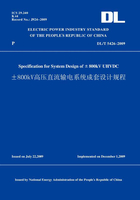
6.3 Main Electrical Connection Design
6.3.1 General requirements
The DC main electrical connection design shall meet the requirements of various operation modes,as well as the following functional requirements:
1 12-pulse converter connection is preferred for each pole or each converter unit.If this is impractical due to equipment restrictions or the need for staged construction,multiple converters in series or parallel can be used for connection.
2 A pole,a converter unit or a converter in the converter station can be isolated and grounded for maintenance purpose.For long-distance HVDC transmission systems,it is possible to:
(1)Isolate and ground the HVDC transmission line of a pole for maintenance.
(2)Isolate and ground electrode(s)and electrode line(s)at one or both converter stations for maintenance in monopolar metallic return mode.
(3)Isolate and ground electrode(s)and electrode line(s)at one or two terminals of the HVDC transmission system for maintenance in bipolar balanced current operation mode(to meet this requirement,all the primary equipment,control,protection and measurement devices required for bipolar balanced operation shall be provided,and the grounding mats at both converter stations shall be used for temporary grounding).
3 Unless it is absolutely necessary and no effect on the stability of the connected system is caused,the removal of the faulty pole,converter or converter unit for maintenance shall not affect the transmission power of the healthy pole,converter or converter unit.
4 In monopolar operation of either pole in a long-distance HVDC transmission system,when switching from ground return to metallic return or vice versa,unless it is absolutely necessary and no effect on the stability of the connected system is caused,the DC transmission power shall not be interrupted or reduced.The time it takes for switching shall usually not be more than 60 seconds.
5 Connecting,disconnecting and grounding a DC filter bank for maintenance shall not interrupt or reduce the DC transmission power.
6 Isolating and grounding the bypass switch for maintenance shall not interrupt or reduce the DC transmission power.
7 Other special connections are possible,such as the de-icing connection when required.
6.3.2 Configuration of high speed switch on the DC side
To meet the overall requirements of main electrical connection,high-speed switches are needed on the DC side,which at least include neutral bus switch(NBS),metallic return transfer breaker(MRTB),ground return transfer switch(GRTS),neutral bus ground switch(NBGS).For the connection of multiple converters in series,converter bypass switches are often required.
6.3.2.1 Neutral bus switch
A high-speed neutral bus switch shall be provided in the neutral bus of each converter pole.This switch shall be rated to interrupt the DC current flow due to any fault that may occur on converter pole and HVDC transmission line.The fault current channel is usually formed by the parallel connection of the fault circuit of the bypass valve and smoothing reactor and the ground return consisting of the electrode and its line,when the healthy pole shall be assumed to be operating under short-term overload rating.
6.3.2.2 Metallic return transfer breaker
An MRTB provided on the side of rectifier is used to transfer the DC current from the low impedance ground return path to the high impedance metallic return path.Under any operation conditions,such a transfer shall not result in the interruption of the DC transmission power.However,whether a reduced power is allowable can be determined by the actual situation of the given project.
6.3.2.3 Ground return transfer switch
A GRTS provided on the rectifier side is used to transfer DC current from high impedance metallic return path to low impedance ground return path.Under any operation conditions,such a transfer shall not result in interrupted DC transmission power.However,whether a reduced power is allowable can be determined by the actual situation of the given project.
6.3.2.4 Neutral bus ground switch
Each converter station is provided with an NBGS.When the electrode quits operation,the NBGSs at both converter stations automatically transfer the neutral bus to the station earth.The switch is not envisaged to have a significant current transfer capability,but shall be capable of opening during bipolar operation and transferring bipolar unbalance current to the electrode.An NBGS shall have the following control and interlocking functions:
—The switch can automatically close when the electrode quits operation.
—An interlocking device is available such that when the current exceeds its transfer capability the switch could not open.
—The control and protection devices can automatically reduce the DC current and trip the pole if the switch closes while in monopolar operation or if one pole blocks while the switch is closed.
6.3.2.5 High speed bypass switch
In HVDC transmission systems which multiple converters connected in series are required for each pole,high speed bypass switches may be used to increase the system reliability.Such switches can isolate converters that are faulty or require maintenance without affecting the normal operation of other equipment.
6.3.3 Converter transformer connection
Where transformers with two windings are used,the AC sides of Y-Y connected transformer and Y-△connected transformer are connected in parallel to the AC bus.The detailed connection shall be determined by how the AC main connection is done.
6.3.4 (Reactive power)Sub-bank connection
The AC filter,shunt capacitor and shunt reactor sub-banks can be connected in bank to the AC bus,or directly connected to it.The proper way of connection should be determined after technical and economic comparison.
6.3.5 AC main electrical connection
The AC main electrical connection can be done with reference to the design requirements in applicable codes for conventional substations.